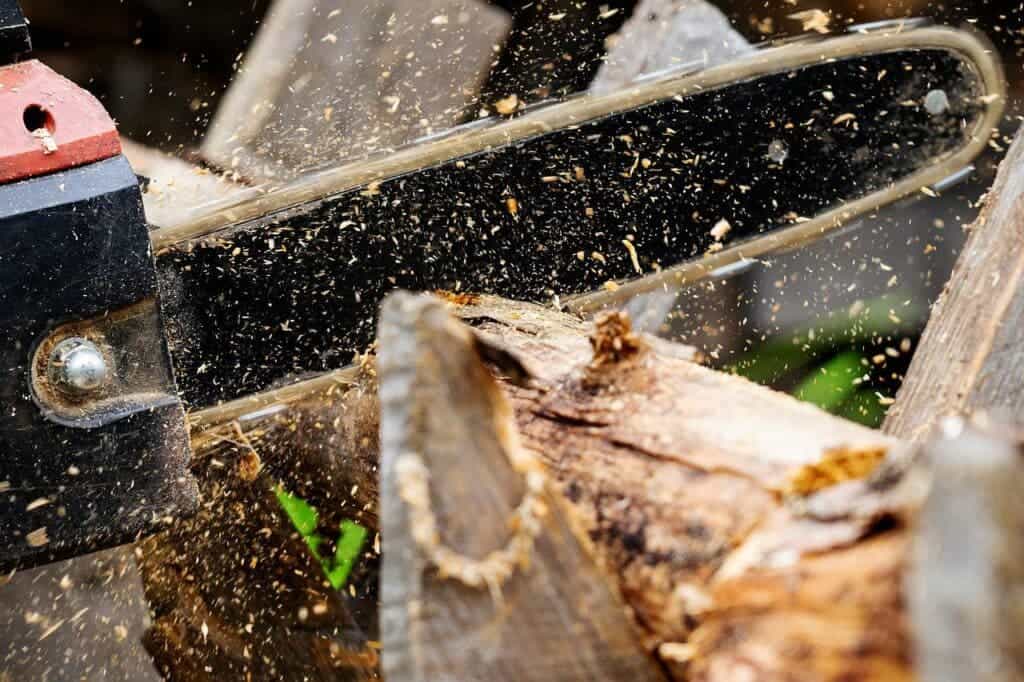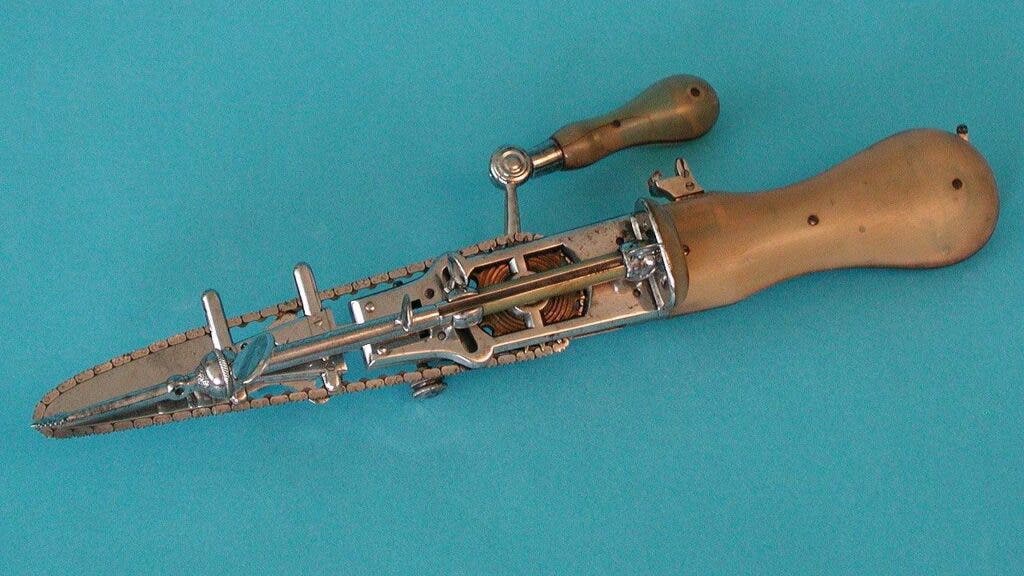
They buzz, they whirl, and they cut the trees down — they are chainsaws. Although the general perception of these tools is deeply linked to the idea of cutting down timber or processing it into planks, that wasn’t the purpose for that these tools were invented to serve. In fact, the roots of these devices stem from the field of medicine, not forestry.
Chainsaws today are mainly used to cut down trees, and for good reason: they’re very good at slicing through hard materials with minimal effort on the part of the user. The energy required to make the cut is produced by the engine the tool is equipped with, rather than an individual’s arm muscles. This makes chainsaws much more convenient to use, and a great deal faster at cutting, than hand saws.
That being said, the chainsaw has a unique place in the public imagination. Video games like to feature chainsaws either as tools or weapons, and horror movies have a particular soft spot for them and the simulated gore they can bring to the screen.
While pop media depicts the chainsaw as an instrument of death and destruction, at its roots, it was meant to help bring life into the world.
In fact, the origins of the chainsaw can be traced back to the late 18th century, when two Scottish doctors named John Aitken and James Jeffray began experimenting with surgical tools that used a chain with serrated teeth to cut through bone.
It wasn’t until the early 20th century, however, that the first modern chainsaw was invented. Remarkably, it wasn’t designed for forestry or carpentry, but for medical procedures.
Why were chainsaws invented?
Childbirth is an undeniably stressful, exhausting process for mothers; this holds true even with the benefits afforded by modern medical technology, know-how, and medication. In the times before these were available, such events could easily become deadly for the mother, the baby, or both.
Just like now, complications could arise during childbirth that would require special intervention from attending doctors or midwives to save the mother, the baby, or both. Today, many such complications are solved through the use of cesarean (or ‘C-‘) sections. This type of intervention is especially useful when the baby is too large to fit through the mother’s birth canal or if they are in a breech position (feet-first in the womb instead of head-first), which can make normal birth impossible.
However, the c-section has not been available as an option for the greater part of history, and it is only safe to perform due to modern tools, training, and medical facilities.
Before c-sections, when the baby would not or could not fit through the birthing canal, surgeons would resort to a procedure known as symphysiotomy. This procedure involved the severing of the mother’s pelvic bone to create enough space for the baby to pass through.
While cutting this bone, the surgeon would need to be careful to damage the surrounding tissues as little as possible, so the symphysiotomy was carried out using a small knife. This could be more easily controlled by the doctor, but it would also be extremely slow at cutting clean through the bone, which increased the risks for the woman. Even so, the cut was often imprecise and rough. It was brutal. Not only that but, seeing as anesthesia was not used, the extra time required would put immense stress on her as the procedure was agonizing and hard to bear.
Around 1780, two Scottish surgeons set about to improve the procedure to give moms-to-be who had to endure a symphysiotomy a better chance at survival. Their design would become the reason why chainsaws were invented.
The osteotome: the original chainsaw

The two doctors, John Aitken and James Jeffray, invented the osteotome to help them and other doctors more easily slice through the pelvic bone. The device, which they named the ‘osteotome’, was in effect the world’s first chainsaw, although you wouldn’t immediately tell by its shape.
It consisted of a long chain fitted with serrated teeth with a handle on each end — these teeth looked like pieces of a knife blade, not like today’s chainsaw teeth. This would be wrapped around the pelvic bone, and the doctor or doctors would alternate pulling on each handle. This created a repeating motion that would help cut through the bone much faster, with less effort, and with more precision than a knife.
It would be further refined into a more stable tool that could be held in a single hand over the years, with a prime example being Bernhard Heine’s osteotome from the 1830s. His version of the device was powered by a hand crank, and the chain was looped around a guiding blade to allow it to rotate. The device combined the effectiveness of the chain osteotome with the ease of use of a regular knife.
Symphysiotomies became much safer and widely accepted after the development of such tools. They also began being used in other types of surgeries or dissections as well, due to their efficacy in cutting through bone.
Osteotomes are still in use today in various medical applications that require the cutting or preparation of bone, such as plastic or dental surgery. However, the modern variants of this tool do not resemble Aitken and Jeffray’s devices at all; they are more like chisels. Today, that original tool is known as a ‘chain osteotome’.
Leaving the surgery room: how the chainsaw went from cutting abdomens to cutting timber
What would drive the osteotome out of the hospital and into the logging camp was better hygiene and anesthesia. Together, these two factors made c-sections much safer to perform and easier to bear for the mother. C-sections also tended to have fewer or no long-term complications, as opposed to symphysiotomies (which could even leave an individual unable to walk for extended periods of time).
As such, symphysiotomies fell out of favor.
But a San Francisco-based resident by the name of Samuel J. Bens would turn the device to cutting another hard material — timber. In 1096, he submitted his patent of the “endless chain saw”, serial No. 302,537. For all intents and purposes, this device is the saw chain in its modern form.
“In Letters Patent granted [January] 17 1905 and numbered 780,476, I described a saw com rising a chain of links carrying saw teeth and running in a guide frame. If [such] guide frames are of considerable length, ‘as in practical use they ought to be, I have found that they are liable to lack the stiffness [requisite] for doing effective work, especially [when] that work is of a heavy character as for instance with the huge redwood timber of the Pacific coast,” Bens explains in his patent letter.
“While the general objects of the present invention are substantially the same as those set forth in the Letters Patent referred to, I have devised and herein describe and show various and useful improvements upon that construction, tending to increase its efficiency and usefulness.”
“Thus I have provided [means] for reinforcing and consequently stiffening the guide frame, and also a better arrangement and construction of saw teeth, I provide alternately arranged cutting teeth and dragging teeth, the latter operating to keep the saw-kerf clear. I have also devised a better means for holding the cutting blades in the frame while at the same time such blades are easily removable and replaceable in cases when renewal or re-sharpening or any kind of repair work is required.”
The final pieces of the puzzle were modern engines that could power chainsaws into their portable but capable form of today.
The first portable chainsaw, the forefather of the tool in the shape we know it today, was developed and patented in 1918 by James Shand, a Canadian millwright. While he held exclusive rights to his patent, further development was slow. However, Shand allowed his rights to lapse in 1930, and the patent was further developed by the German company Festo — which still produced portable chainsaws to this day under the name Festool.
These early chainsaws were heavy and cumbersome, often requiring two people to operate. But they were also incredibly powerful, capable of cutting through large trees in a fraction of the time it would take to chop them down with an axe or saw.
As technology improved, so did the chainsaw. By the 1950s, lightweight and portable chainsaws had become commonplace, revolutionizing the forestry industry and making it possible to harvest timber more efficiently than ever before.
But the chainsaw’s impact extends far beyond the world of forestry. Today, chainsaws are used in a wide range of industries, from construction and demolition to ice sculpting and even art.
Despite its humble origins as a surgical tool, the chainsaw has become one of the most versatile and indispensable tools in modern society. And while its power and potential for harm should never be underestimated, there’s no denying the impact that this innovative and unexpected invention has had on the world.


